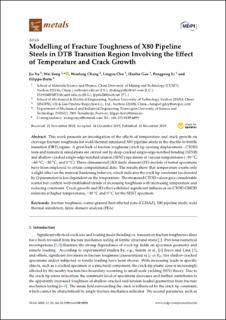| dc.contributor.author | Xu, Jie | |
| dc.contributor.author | Song, Wei | |
| dc.contributor.author | Cheng, Wenfeng | |
| dc.contributor.author | Chu, Lingyu | |
| dc.contributor.author | Gao, Hanlin | |
| dc.contributor.author | Li, Pengpeng | |
| dc.contributor.author | Berto, Filippo | |
| dc.date.accessioned | 2022-05-04T11:37:32Z | |
| dc.date.available | 2022-05-04T11:37:32Z | |
| dc.date.created | 2020-09-23T17:26:59Z | |
| dc.date.issued | 2020 | |
| dc.identifier.citation | Metals. 2020, 10 (1), 1-14. | en_US |
| dc.identifier.issn | 2075-4701 | |
| dc.identifier.uri | https://hdl.handle.net/11250/2994166 | |
| dc.description.abstract | This work presents an investigation of the effects of temperature and crack growth on cleavage fracture toughness for weld thermal simulated X80 pipeline steels in the ductile-to-brittle transition (DBT) regime. A great bulk of fracture toughness (crack tip opening displacement—CTOD) tests and numerical simulations are carried out by deep-cracked single-edge-notched bending (SENB) and shallow-cracked single-edge-notched tension (SENT) specimens at various temperatures (−90 °C, −60 °C, −30 °C, and 0 °C). Three-dimensional (3D) finite element (FE) models of tested specimens have been employed to obtain computational data. The results show that temperature exerts only a slight effect on the material hardening behavior, which indicates the crack tip constraint (as denoted by Q-parameter) is less dependent on the temperature. The measured CTOD-values give considerable scatter but confirm well-established trends of increasing toughness with increasing temperature and reducing constraint. Crack growth and 3D effect exhibited significant influences on CTOD-CMOD relations at higher temperatures, −30 °C and 0 °C for the SENT specimen. | en_US |
| dc.language.iso | eng | en_US |
| dc.publisher | MDPI | en_US |
| dc.rights | Navngivelse 4.0 Internasjonal | * |
| dc.rights.uri | http://creativecommons.org/licenses/by/4.0/deed.no | * |
| dc.title | Modelling of fracture toughness of x80 pipeline steels in dtb transition region involving the effect of temperature and crack growth | en_US |
| dc.title.alternative | Modelling of fracture toughness of x80 pipeline steels in dtb transition region involving the effect of temperature and crack growth | en_US |
| dc.type | Peer reviewed | en_US |
| dc.type | Journal article | en_US |
| dc.description.version | publishedVersion | en_US |
| dc.source.pagenumber | 1-14 | en_US |
| dc.source.volume | 10 | en_US |
| dc.source.journal | Metals | en_US |
| dc.source.issue | 1 | en_US |
| dc.identifier.doi | 10.3390/met10010028 | |
| dc.identifier.cristin | 1832713 | |
| cristin.ispublished | true | |
| cristin.fulltext | original | |
| cristin.qualitycode | 1 | |

